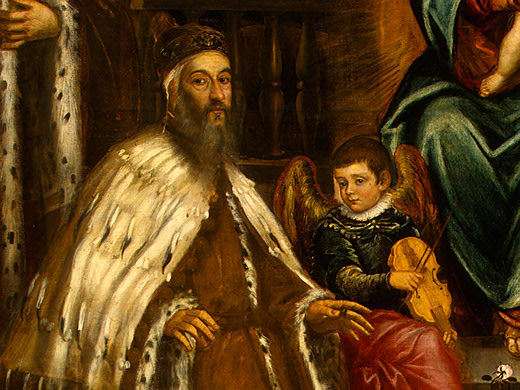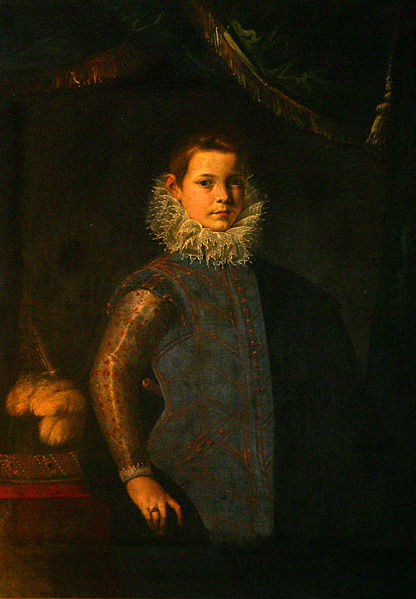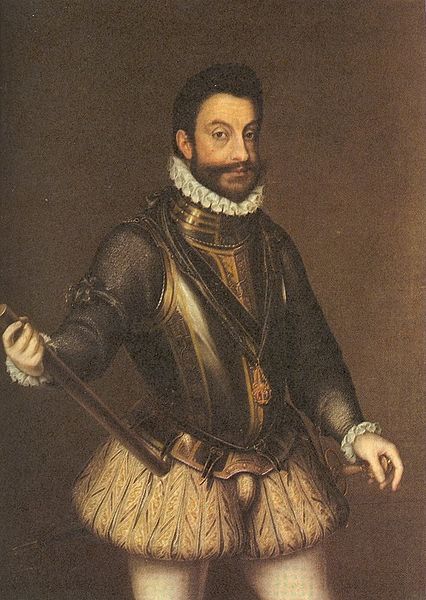<Back to Index>
- Doge of Venice Alvise I Mocenigo, 1507
- Grand Duke of Tuscany Cosimo I de' Medici, 1519
- Duke of Savoy Emanuele "Testa di Ferro" Filiberto, 1528
PAGE SPONSOR

Alvise I Mocenigo (26 October 1507 – 4 June 1577) was doge of Venice from 1570 to 1577.
An admirer of antiquities, Mocenigo was a diplomat of the Republic of Venice at the court of emperor Charles V (1545), to pope Paul IV (1557) and again at the imperial court (1564). In 1567 he was a candidate to the election as doge, but lost to Pietro Loredan. He participated again when the latter died, and was elected as doge of Venice in 1570.
At the time of his accession, the Ottoman Empire was preparing to wage war against Venice: the conflict broke out in 1570, and Venice lost the fortresses of Nicosia and Famagusta in Cyprus. Despite the victory of the Christian coalition in the Battle of Lepanto, Venice was forced to sign an unfavorable treaty of peace with the Turks (7 March 1573), by which it recognized the loss of Cyprus.
During his reign Venice was visited by the new King of France, Henry III, in July 1574. He was interred in the Basilica di San Giovanni e Paolo, a traditional burial place of the doges.

Cosimo I de' Medici (12 June 1519 – 21 April 1574) was Duke of Florence from 1537 to 1574, reigning as the first Grand Duke of Tuscany from 1569.
Cosimo was born in Florence, on June 12, 1519, the son of the famous condottiere Giovanni dalle Bande Nere from Forlì and Maria Salviati. Cosimo came to power at 17, when the 26 year old Duke, Alessandro de' Medici, was assassinated in 1537, as Alessandro's only male child was illegitimate. Cosimo was from a different branch of the family, and so far had lived in Mugello, and was almost unknown in Florence: however, many of the influential men in the city favored him, several of them hoping to rule through him and thereby enrich themselves at the state's expense. However, as Benedetto Varchi famously put it "The innkeeper's reckoning was different from the glutton's." Cosimo proved strong willed, astute and ambitious, and soon rejected the clause he had signed, which entrusted much of the power to a council of Forty - Eight.
When the Florentine exiles heard of the death of Alessandro, they marshaled their forces with support from France and from disgruntled neighbors of Florence. During this time, Cosimo had an illegitimate daughter, Bia (1537 – 1542), who was portrayed shortly before her premature death in a marvelous painting by Bronzino.
Toward the end of July 1537, the exiles marched into Tuscany under the leadership of Bernardo Salviati and Piero Strozzi. When Cosimo heard of their approach, he sent his best troops under Alessandro Vitelli to engage the enemy, which they did at Montemurlo, a fortress that belonged to the Nerli. After defeating the exiles' army, Vitelli stormed the fortress, where Strozzi and a few of his companions had retreated to safety. It fell after only a few hours, and Cosimo celebrated his first victory. The prominent prisoners were subsequently beheaded on the Piazza or in the Bargello. Filippo Strozzi's body was found with a bloody sword next to it and a note quoting Virgil, but many believe that his suicide was faked.
In June 1537 Cosimo was recognized as head of the Florentine state by the Holy Roman Emperor Charles V, in exchange for help against France in the course of the Italian Wars. With this move he firmly restored the power of the Medici, who thereafter ruled Florence until the death of the last of the Medici, Gian Gastone de' Medici, in 1737. The help granted to Charles V allowed him to free Tuscany from the Imperial garrisons, and to increase as much as possible its independence from the overwhelming Spanish influence in Italy.
Cosimo next turned on Siena. With the support of the Emperor, he defeated the Sienese at the Battle of Marciano (1554), and laid siege to Siena. Despite the inhabitants' desperate resistance, on April 17, 1555, after a 15 month siege, the city fell, its population diminished from forty thousand to eight thousand. In 1559 Montalcino, the last redoubt of Sienese independence, was annexed to Cosimo's territories. In 1569, Pope Pius V elevated him to the position of Grand Duke of Tuscany.
Cosimo was an authoritarian ruler and secured his position by employing a guard of Swiss mercenaries. In 1548 he managed to have his relative Lorenzino, the last Medici claimant to Florence, assassinated in Venice.
Cosimo also was an active builder of military structures, in an attempt to save his state from the frequent passage of foreign armies (examples are the new fortresses of Siena, Arezzo, Sansepolcro, the new walls of Pisa and Fivizzano, and the strongholds of Portoferraio, on the island of Elba, and Terra del Sole).
He laid heavy tax burdens on his subjects. Despite his economic difficulties, he was a lavish patron of the arts and also developed the Florentine navy, which eventually took part in the Battle of Lepanto, and which he entrusted to his new creation, the military Order of St. Stephen.
In the last 10 years of his reign, struck by the death of two of his sons by malaria, Cosimo gave up the active rule to his son and successor Francesco I de' Medici, Grand Duke of Tuscany. He retreated to live in his villa, Villa di Castello, outside Florence.
Cosimo is perhaps best known today for the creation of the Uffizi ("offices"). Originally intended as a means of consolidating his administrative control of the various committees, agencies, and guilds established in Florence's Republican past, it now houses one of the world's most important collections of art, much of it commissioned and/or owned by various Medici. He also finished the Pitti Palace as a home for the Medici and created the magnificent Boboli Gardens behind the Pitti. As his more prominent ancestors had been, he was also an important patron of the arts, supporting, among others, Vasari, Cellini, Pontormo, Bronzino, the architect Lanci, and the historians Scipione Ammirato and Benedetto Varchi.
A large bronze equestrian statue of Cosimo I by Giambologna, erected in 1598, still stands today in the Piazza della Signoria, the main square of Florence.
Cosimo was also an enthusiast of alchemy, a passion he had inherited from his grandmother Caterina Sforza.
In 1539, he married Eleonora di Toledo (1522 – 1562), the daughter of Don Pedro Álvarez de Toledo, the Spanish viceroy of Naples. Her face is still familiar to many because of her solemn and distant portraits by Agnolo Bronzino. The most famous of them, with her son Giovanni, hangs in the Uffizi Gallery. She provided the Medici with the Pitti Palace and seven sons to ensure male succession and four daughters to connect the Medici with noble and ruling houses in Italy. She was a patron of the new Jesuit order, and her private chapel in the Palazzo Vecchio was decorated by Bronzino, who had originally arrived in Florence to provide festive decor for her wedding. She died, with her sons Giovanni and Garzia, in 1562, when she was only forty; all three of them were struck down by malaria while traveling to Pisa.
Before his first marriage, Cosimo fathered an illegitimate daughter with an unknown woman: Bia de' Medici (ca. 1536 – March 1, 1542)
With Eleonora, Cosimo fathered eleven children: Maria (April 3, 1540 – November 19, 1557); Francesco (March 25, 1541 – October 19, 1587) Cosimo's successor as Grand Duke of Tuscany; Isabella (August 31, 1542 – July 16, 1576) was murdered by her husband Paolo Giordano I Orsini because of infidelity; Giovanni (September 28, 1543 – November 1562) became Bishop of Pisa and cardinal; Lucrezia (June 7, 1545 – April 21, 1561) in 1560 married of Alfonso II d'Este, Duke of Ferrara and Modena; Pietro (Pedricco) (August 10, 1546 – June 10, 1547); Garzia (July 5, 1547 – December 12, 1562); Antonio (1548 – 1548); Ferdinando (July 30, 1549 – February 17, 1609) Francesco's successor as Grand Duke of Tuscany; Anna (1553 – 1553); Don Pietro de' Medici (June 3, 1554 – April 25, 1604) murdered his wife Eleonora di Garzia di Toledo because of infidelity.
After Eleonora's death in 1562, Cosimo fathered two children with his mistress Eleonora degli Albrizzi: unnamed daughter (born and died 1566) died before baptism; Giovanni (1567 – 1621) later legitimized by his father
In 1570, Cosimo married Camilla Martelli (died 1590) and fathered one child with her: Virginia (May 29, 1568 – January 15, 1615) married Cesare d'Este, Duke of Modena.

Emmanuel Philibert (in Italian Emanuele Filiberto; known as "Testa di ferro", in English "Ironhead", because of his military career; 8 July 1528 – 30 August 1580) was Duke of Savoy from 1553 to 1580.
Born in Chambéry, Emmanuel Philibert was the only child of Charles III, Duke of Savoy and Beatrice of Portugal to reach adulthood. His mother was sister - in - law to Charles V, Holy Roman Emperor, and the future duke served in Charles's army during the war against Francis I of France, distinguishing himself by capturing Hesdin in July 1553. A month later, he became duke on the death of his father, but this was a nearly empty honor, as the vast majority of his hereditary lands had been occupied and administered by the French since 1536. Instead, he continued to serve the Habsburgs in hopes of recovering his lands, and served his maternal first cousin King Philip II as Governor of the Netherlands from 1555 - 1559.
In this capacity he personally led the Spanish invasion of northern France and won a brilliant victory at Saint - Quentin in August 1557. He was a suitor to Lady Elizabeth Tudor, the future Queen Elizabeth I. He had barely any money at that time.
By the Peace of Cateau Cambrésis between France and Spain, (1559) the duchy was restored to Emmanuel Philibert and he married his half - first cousin once removed Margaret of France, Duchess of Berry (1523 – 1574), daughter of King Francis I of France and sister to King Henry II. Their only child was Charles Emmanuel I of Savoy.
Following his uncle's, Henry I of Portugal, death (31 January 1580) Emmanuel Philibert fought to impose his rights as a claimant to the Portuguese throne. However, he soon realized that he had quite a fragile position due to his cousin, Philip II of Spain claims who, in the end, managed to conquer the country and the Crown.
Emmanuel Philibert spent his rule regaining what had been lost in the costly wars with France. A skilled political strategist, he took advantage of various squabbles in Europe to slowly regain territory from both the French and the Spanish, including the city of Turin. He also purchased two territories. Internally, he moved the capital of the duchy from Chambéry to Turin and replaced Latin as the duchy's official language with Italian. He was attempting to acquire the marquisate of Saluzzo when he died in Turin.